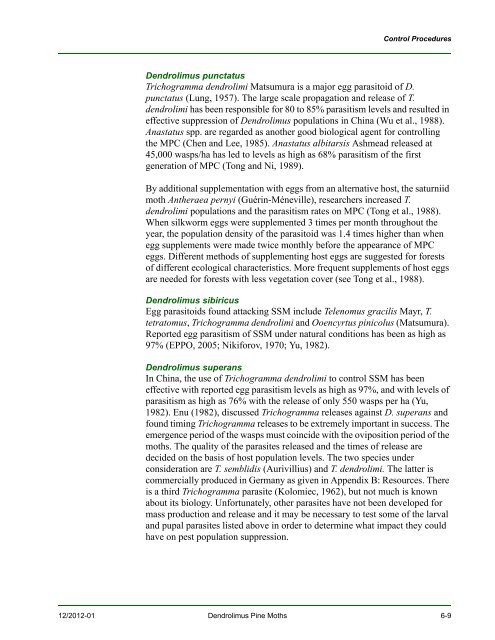New Pest Response Guidelines - aphis - US Department of Agriculture
New Pest Response Guidelines - aphis - US Department of Agriculture
New Pest Response Guidelines - aphis - US Department of Agriculture
Create successful ePaper yourself
Turn your PDF publications into a flip-book with our unique Google optimized e-Paper software.
Control Procedures<br />
Dendrolimus punctatus<br />
Trichogramma dendrolimi Matsumura is a major egg parasitoid <strong>of</strong> D.<br />
punctatus (Lung, 1957). The large scale propagation and release <strong>of</strong> T.<br />
dendrolimi has been responsible for 80 to 85% parasitism levels and resulted in<br />
effective suppression <strong>of</strong> Dendrolimus populations in China (Wu et al., 1988).<br />
Anastatus spp. are regarded as another good biological agent for controlling<br />
the MPC (Chen and Lee, 1985). Anastatus albitarsis Ashmead released at<br />
45,000 wasps/ha has led to levels as high as 68% parasitism <strong>of</strong> the first<br />
generation <strong>of</strong> MPC (Tong and Ni, 1989).<br />
By additional supplementation with eggs from an alternative host, the saturniid<br />
moth Antheraea pernyi (Guérin-Méneville), researchers increased T.<br />
dendrolimi populations and the parasitism rates on MPC (Tong et al., 1988).<br />
When silkworm eggs were supplemented 3 times per month throughout the<br />
year, the population density <strong>of</strong> the parasitoid was 1.4 times higher than when<br />
egg supplements were made twice monthly before the appearance <strong>of</strong> MPC<br />
eggs. Different methods <strong>of</strong> supplementing host eggs are suggested for forests<br />
<strong>of</strong> different ecological characteristics. More frequent supplements <strong>of</strong> host eggs<br />
are needed for forests with less vegetation cover (see Tong et al., 1988).<br />
Dendrolimus sibiricus<br />
Egg parasitoids found attacking SSM include Telenomus gracilis Mayr, T.<br />
tetratomus, Trichogramma dendrolimi and Ooencyrtus pinicolus (Matsumura).<br />
Reported egg parasitism <strong>of</strong> SSM under natural conditions has been as high as<br />
97% (EPPO, 2005; Nikiforov, 1970; Yu, 1982).<br />
Dendrolimus superans<br />
In China, the use <strong>of</strong> Trichogramma dendrolimi to control SSM has been<br />
effective with reported egg parasitism levels as high as 97%, and with levels <strong>of</strong><br />
parasitism as high as 76% with the release <strong>of</strong> only 550 wasps per ha (Yu,<br />
1982). Enu (1982), discussed Trichogramma releases against D. superans and<br />
found timing Trichogramma releases to be extremely important in success. The<br />
emergence period <strong>of</strong> the wasps must coincide with the oviposition period <strong>of</strong> the<br />
moths. The quality <strong>of</strong> the parasites released and the times <strong>of</strong> release are<br />
decided on the basis <strong>of</strong> host population levels. The two species under<br />
consideration are T. semblidis (Aurivillius) and T. dendrolimi. The latter is<br />
commercially produced in Germany as given in Appendix B: Resources. There<br />
is a third Trichogramma parasite (Kolomiec, 1962), but not much is known<br />
about its biology. Unfortunately, other parasites have not been developed for<br />
mass production and release and it may be necessary to test some <strong>of</strong> the larval<br />
and pupal parasites listed above in order to determine what impact they could<br />
have on pest population suppression.<br />
12/2012-01 Dendrolimus Pine Moths 6-9

















